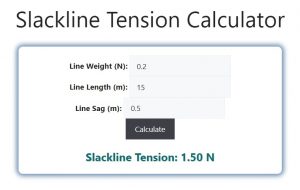About Slackline Tension Calculator (Formula)
Slacklining has gained immense popularity as a thrilling outdoor activity that challenges balance and coordination. One of the crucial aspects of setting up a slackline is ensuring that the tension is just right. Too little tension can lead to an unsafe and unstable line, while too much can risk breakage. The Slackline Tension Calculator provides an easy way to determine the optimal tension based on key variables. In this article, we’ll explain the formula used, guide you on how to use it effectively, provide a practical example, and answer common questions related to slackline tension.
Formula
The formula for calculating slackline tension is:
ST = (Line Weight * Line Length) / (4 * Line Sag).
Where:
- ST represents the Slackline Tension.
- Line Weight is the weight of the slackline per unit length.
- Line Length is the total length of the slackline.
- Line Sag refers to the vertical drop in the middle of the slackline when it is set up.
How to Use
- Gather Required Measurements: Before using the calculator, measure the line weight (usually given in kg/m), line length (in meters), and the line sag (in meters).
- Plug Values into the Formula: Insert the gathered values into the formula ST = (Line Weight * Line Length) / (4 * Line Sag).
- Calculate the Slackline Tension: Perform the calculation to determine the required tension for your slackline setup.
- Adjust Your Slackline Setup: Based on the calculated tension, adjust the slackline accordingly using your chosen tensioning system to achieve the optimal level of tautness.
Example
Let’s say you have the following measurements for your slackline:
- Line Weight: 0.2 kg/m
- Line Length: 15 m
- Line Sag: 0.5 m
Using the formula, we can calculate the Slackline Tension:
- ST = (0.2 kg/m * 15 m) / (4 * 0.5 m).
- ST = (3 kg) / (2 m).
- ST = 1.5 kg.
In this example, the required slackline tension is 1.5 kg.

FAQs
- What is slacklining?
Slacklining is a balance sport where a length of flat webbing is tensioned between two anchors and walked upon. - Why is tension important in slacklining?
Proper tension ensures the line is stable for walking and reduces the risk of falls or line breakage. - What factors affect slackline tension?
Key factors include line weight, line length, and line sag. - How can I measure line sag?
Line sag can be measured by finding the vertical drop in the center of the line between the two anchors. - Is there a recommended tension for beginners?
Beginners often benefit from lower tension for easier balance while learning. - How tight should my slackline be?
The slackline should be tight enough to support weight without excessive sag, allowing for a stable walking surface. - Can I slackline on uneven ground?
Yes, but be cautious as it may require more adjustments to maintain proper tension and safety. - What types of anchors can I use?
Suitable anchors include trees, poles, or specialized slackline stands that are securely grounded. - What if my slackline feels too bouncy?
If your slackline feels bouncy, it may be too loose. Adjust the tension according to your calculated ST. - How often should I check my slackline tension?
It’s advisable to check the tension each time you set up the slackline, especially after adjustments or after use. - Can I use the calculator for different types of slacklines?
Yes, the formula can be adapted for various slackline setups, including trick lines and longlines. - What is the maximum weight a slackline can support?
The maximum weight varies based on the slackline material and construction. Always refer to the manufacturer’s specifications. - How do weather conditions affect slacklining?
Weather can affect grip and tension; wet or windy conditions may require increased caution and adjustments. - Is slacklining safe?
Slacklining can be safe when proper setup, equipment, and safety practices are followed. - What safety gear should I use while slacklining?
A helmet, knee pads, and a spotter can enhance safety during practice, especially for beginners. - Can I slackline alone?
While it’s possible, having a partner or spotter is recommended for safety, particularly when learning new skills. - What materials are slacklines made of?
Slacklines are typically made of durable polyester or nylon webbing, designed for strength and flexibility. - How do I store my slackline?
Store your slackline in a cool, dry place, away from direct sunlight to prolong its lifespan. - Can I practice tricks on my slackline?
Yes, once you’re comfortable walking on the slackline, you can start practicing various tricks. - What should I do if my slackline breaks?
Immediately cease use and inspect the break. Replace the slackline if it shows signs of wear or damage.
Conclusion
The Slackline Tension Calculator is an essential tool for both novice and experienced slackliners. Understanding how to measure the necessary tension ensures a safer and more enjoyable slacklining experience. By following the outlined steps and utilizing the formula, you can confidently set up your slackline and focus on developing your skills. Whether you’re practicing balance or performing tricks, the right tension is crucial for success and safety in this exhilarating activity.